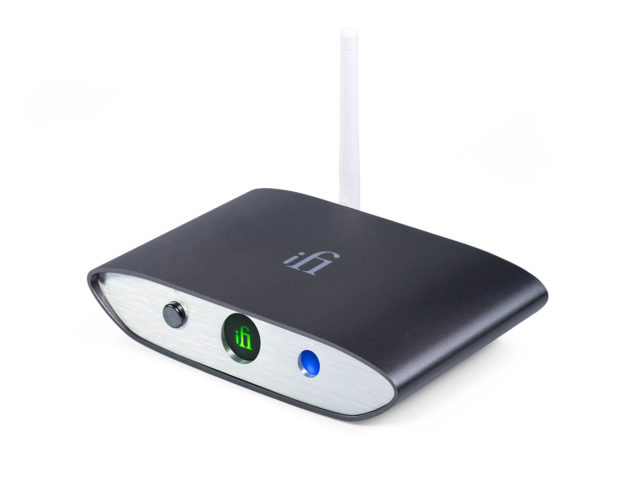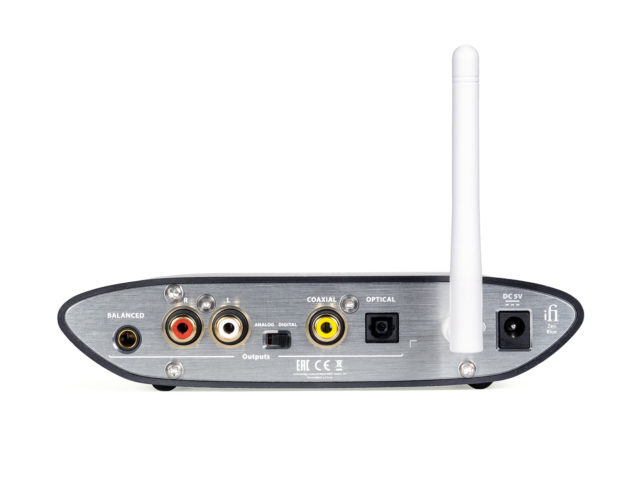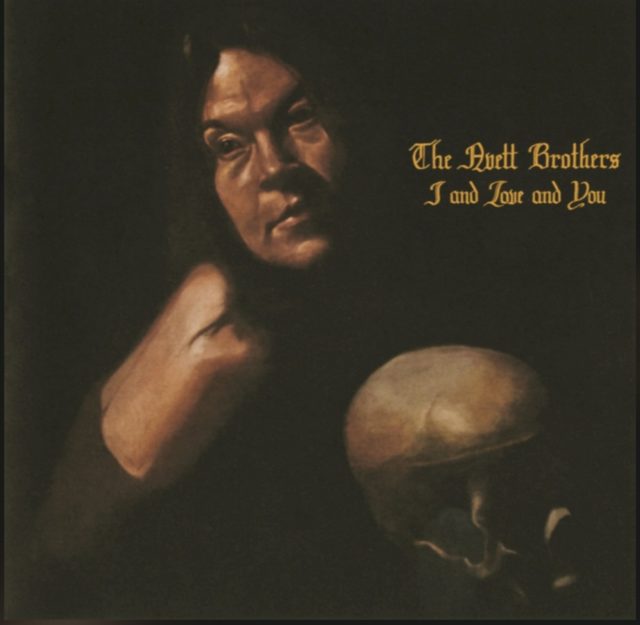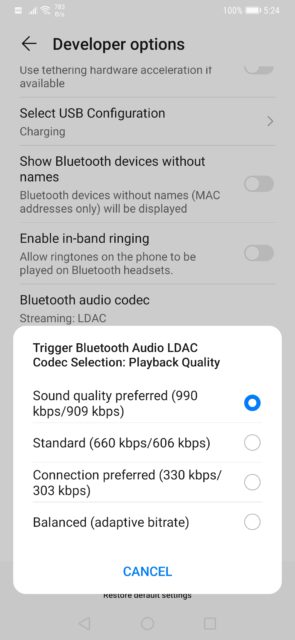Review by Noam Bronstein
Continuing my Bluetooth / aptX journey begun a few weeks ago, here is the first of a series of mini-reviews of audio gear that tries to make the most of these technologies.
 iFi Audio’s Zen Blue is a wireless DAC – specifically, it’s billed as a high-resolution Bluetooth streamer. This is a dedicated Bluetooth unit: it has a range of output options, but the only way it can receive a signal is from a Bluetooth device (smartphone, tablet, computer). Blessing it with a retail price of only $179 CAD, iFi is looking to put the Zen Blue into existing systems, be they traditional hi-fi’s, or powered speakers that lack a wireless option. It does not have a headphone output. The idea here is a DAC that takes (wireless) music, as data from your device, and sends it (with wires) to your stereo. It’s an interface.
iFi Audio’s Zen Blue is a wireless DAC – specifically, it’s billed as a high-resolution Bluetooth streamer. This is a dedicated Bluetooth unit: it has a range of output options, but the only way it can receive a signal is from a Bluetooth device (smartphone, tablet, computer). Blessing it with a retail price of only $179 CAD, iFi is looking to put the Zen Blue into existing systems, be they traditional hi-fi’s, or powered speakers that lack a wireless option. It does not have a headphone output. The idea here is a DAC that takes (wireless) music, as data from your device, and sends it (with wires) to your stereo. It’s an interface.
The Zen Blue comes well packaged and has a purposeful, chunky feel. Small, but solid. It’s simple to set up and connect. First you’ll need to decide on an output – traditional analog with an RCA interconnect, digital with a coaxial or optical cable, or balanced to a pro audio unit. Make that connection, plug the 5V wall-wart into the socket, and go. If you did choose a digital output, you’d be sending the signal to another DAC. I concerned myself only with the analog outs – i.e. I used the Zen Blue as both streamer and DAC. My guess is that 90% of Zen Blue buyers will be doing the same.
 The model of ESS Sabre DAC in the Zen Blue is not identified in any of the info I’ve seen. The one-page manual indicates that the LED shines blue when decoding a 44/48KHz sample rate, and white if it manages 88/96KHz. Good enough. If you can get something approaching redbook CD level sound quality from Bluetooth, you’re doing alright. We aren’t expecting miracles here.
The model of ESS Sabre DAC in the Zen Blue is not identified in any of the info I’ve seen. The one-page manual indicates that the LED shines blue when decoding a 44/48KHz sample rate, and white if it manages 88/96KHz. Good enough. If you can get something approaching redbook CD level sound quality from Bluetooth, you’re doing alright. We aren’t expecting miracles here.
Usage
Impressive from the start was the build quality and ease of use. The Zen Blue supports every major Bluetooth audio codec (at least up to 2019 or so) – and you can control that from your phone/device, though it may take perseverence, as I outlined in my intro article. When you switch codec, a Siri-ish voice comes over your speakers to let you know that it happened. A nice touch, since the changeover takes a couple of seconds – you impatient types don’t have to keep thumbing the phone and wondering if anything’s happening. If you have great colour memory, you can look at the Zen Blue’s lamp to confirm:
Format LED
AAC Yellow
aptX Blue
aptX HD Magenta
LDAC Cyan
HWA White
SBC Green
In the Developer Options settings, my Huawei phone (Android) gave me all the above codec options. If you don’t have a Huawei device, you may not see HWA – Huawei at this point is the only phone supporting it. The AAC codec is preferred by Apple for its iOS devices, and is what we’re listening to on YouTube streams.
All told, the Zen Blue is a breeze to use. It sleeps when not in use and never needs to be powered on or off. You really never need to touch it. Simply pair a device and start playing tunes.
Let’s Play Some Music
I’ll cut to the chase. For me, LDAC was noticeably better than all the others. I didn’t try the Zen Blue with an Apple device; if you’re an iOS user or watch a lot of YouTube, you’ll be hearing AAC, which is decent but lossy and manipulated by some psychoacoustic algorithms. SBC and HWA sounded inferior, I stuck with aptX and LDAC. *It’s possible that iFi will issue firmware to update its chipset for newer codecs like LHDC, as that’s what they apparently did with LDAC.
 My wife and I spent many hours playing music from our phones through the iFi. I played the Avett Brothers’ beautiful ballad I And Love And You quite a bit, for on-the-fly switching (back and forth comparisons) between the codecs. Tonally, this track has a pretty well-recorded piano and vocal intro, and when the rythym section eventually comes in, you can get a good idea of how well your source is rendering the timing and drive. The LDAC codec was just better across the board. aptX HD was OK, but LDAC bettered it handily every time. It may have been less noticeable with lousy recordings, but it was always clear and obvious. Well done, Sony.
My wife and I spent many hours playing music from our phones through the iFi. I played the Avett Brothers’ beautiful ballad I And Love And You quite a bit, for on-the-fly switching (back and forth comparisons) between the codecs. Tonally, this track has a pretty well-recorded piano and vocal intro, and when the rythym section eventually comes in, you can get a good idea of how well your source is rendering the timing and drive. The LDAC codec was just better across the board. aptX HD was OK, but LDAC bettered it handily every time. It may have been less noticeable with lousy recordings, but it was always clear and obvious. Well done, Sony.
Overall I found the Zen Blue’s sound quality to be quite good into my big system. It was good enough to hear differences in recording quality, and when I replaced the supplied interconnect with a 0.5m OCC, I noticed the improvement. People with high end digital systems will be looking for something with more bandwidth than Bluetooth can provide, but for many applications, this will be more than good enough. It allows everyone in your family to connect with their device and play music on the hi-fi. If used with powered speakers, or say a bedroom or cottage system, Zen Blue can easily turn your phone into your main (or only) music source.
Issues
 I did experience occasional dropouts while streaming to the Zen Blue. Sometimes it was bad, sometimes mostly fine. We live in a small town in a rural area, and our internet isn’t the greatest. But we normally can stream music and video over our WiFi with no issues. I think jamming CD levels of bits and samples through a Bluetooth sized pipe might start showing some of its limitations. You have two devices talking to each other over limited bandwidth, and the data rates and codecs they converse in are complex and not always perfectly in sync. There are optimization settings which can help – basically by reducing the throughput and lowering the audio quality. BT is vulnerable to physical and airborne interference.
I did experience occasional dropouts while streaming to the Zen Blue. Sometimes it was bad, sometimes mostly fine. We live in a small town in a rural area, and our internet isn’t the greatest. But we normally can stream music and video over our WiFi with no issues. I think jamming CD levels of bits and samples through a Bluetooth sized pipe might start showing some of its limitations. You have two devices talking to each other over limited bandwidth, and the data rates and codecs they converse in are complex and not always perfectly in sync. There are optimization settings which can help – basically by reducing the throughput and lowering the audio quality. BT is vulnerable to physical and airborne interference.
Proximity is also a factor: Bluetooth will have more dropouts the further you take the transmitter away from the receiver. I always stayed within 10-20 feet, and between those two distances (on the couch vs going to the kitchen) there wasn’t much difference in the performance. I didn’t try getting really close to the receiver, the way Bluetooth works in a car for example.
In the end, I think these glitches fall under “Bluetooth issues” and “streaming issues”, meaning it is hard to pin them on a piece of hardware or software. I don’t have reason to think they’re specific to the Zen Blue itself. A few times the unit did “seize up”, likely due to too much eagerness on my part with my Android settings. When this happened, a simple unplug reboot was needed.
Conclusions
I wouldn’t hesitate to recommend the iFi Zen Blue to anyone in the market for a unit like this. This was not an exhaustive review, and I didn’t evaluate its potential when used strictly as a streamer. The fact that it has that versatility is another point in its favour.
| Pros | Cons |
| Very affordable | Occasional dropouts |
| Versatile | |
| Good sound quality | |
| Supports many codecs |
iFi Audio Zen Blue Bluetooth Streaming DAC
MSRP $179 CAD ($129 USD)
Web: https://ifi-audio.com/products/zen-blue/
Loan courtesy of: Motet Distribution
In the next installment, I’ll review the Hifiman Ananda-BT, considered to be the world’s best Bluetooth headphone.


Hey Noam: An interesting comparison of Bluetooth codecs. To offer a counterpoint, here’s a link that looks more closely at (Sony’s) LDAC:
https://www.soundguys.com/ldac-ultimate-bluetooth-guide-20026/
A couple snippets/quotes:
” …Unfortunately, LDAC’s 330kbps setting has noticeably worse quality.”
” …Regular Bluetooth SBC is nowhere near this bad, and this is by far the worst high-frequency performance I have seen from any Bluetooth codec.”
” …When set to CD quality, 330kbps LDAC is much the same as before. The noise floor profile fits into the same margin of error, stuck in the region of -83dB for low frequencies, -75dB in the mids, and as high as -33dB near the cut-off frequency. It performs worse than aptX and regular Bluetooth SBC at all frequencies, yet all use similar bandwidths.”
Naturally, the ‘numbers’ may not speak to perceived SQ, but it does appear to speak to the over-ambitious advertising/marketing of Sony’s LDAC. In fact, I feel both Sony/LDAC and Bob Stuart/Meridian-MQA may share the same advertising company. Heck, they may have even shared “notes” over a few too many beers !
peter jasz
(P.S> You stated: ” …You’ll be hearing AAC, which is decent but lossy and manipulated by some psychoacoustic algorithms.”
EVERY format you listed is a lossy/compression format that uses ‘Psycho-acoustic’ Algorithms.
That article is a couple of years old and the Android 8 phones tested with LDAC were mostly achieving 330 and 660kb “best effort” marks. My phone supports 990kb as shown in the screenshot.
Lol -Hi Noam: Two-years old ONLY ? That’s recent 9LIKE YESTERDAY) for me! (lol)
I know nothing of BT codec’s, but man regular, modern ACC/MP-3 Algorithms are light-years ahead of original 320 Kb/s MP-3 compression. In fact, some (128-320 kb/s) are scary-good !
pj
Hey, where did you get a pic of me ?
Cheers,
pj
According to iFi’s product page the device is using a ESS Sabre Hyperstream DAC, not a Cirrus Logic one. I’d suggest updating this article to reflect that.
Noted, thanks.